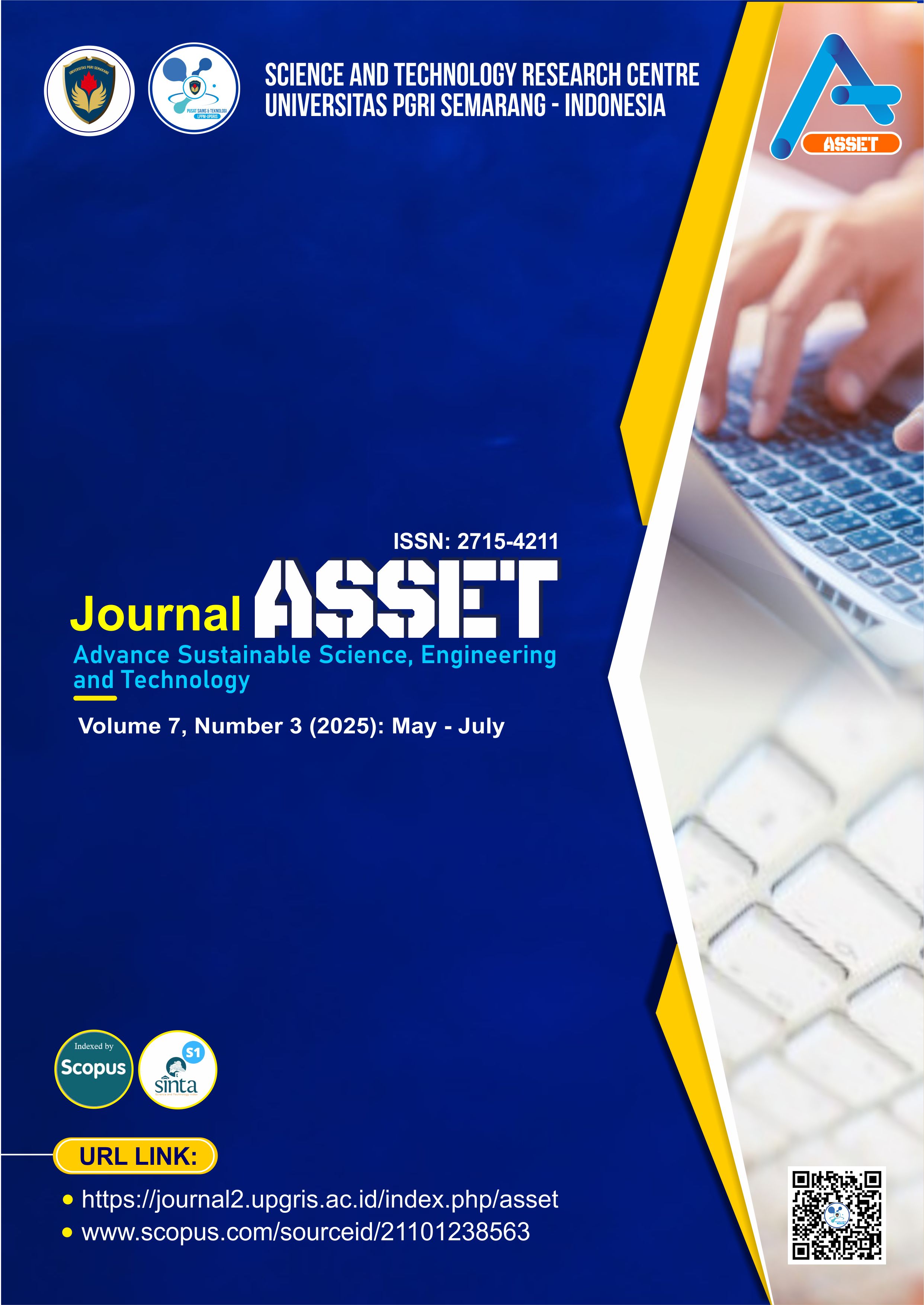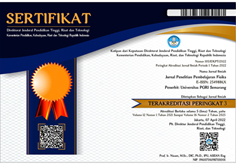Effect of Natural Fiber Stacking Sequence on the Properties of Hybrid Composites for Drone Frame Applications
DOI:
https://doi.org/10.26877/asset.v7i4.2048Keywords:
drone frame materials, hybrid composites, mechanical characterization, natural fiber reinforcement, textile waste recyclingAbstract
The present study highlights the effective utilization of waste fibers in structural composites for drone frame applications, offering a sustainable pathway for developing high-performance materials while simultaneously addressing the issue of textile waste pollution. This study investigates the effect of ramie and cotton fiber waste fabric stacking sequences on the physical and mechanical properties of composites for quadcopter drone frames. Waste fabric was selected as an eco-friendly material to address textile pollution. The composites were fabricated using the hand lay-up technique with a 3:1 epoxy resin to hardener ratio, incorporating five layers of fabric in different configurations. The physical and mechanical properties, including density, water absorption, material hardness, flexural strength, and macro photography, were tested. The results showed that the composite made from fully cotton fabric (K-K-K-K-K) had the best density (1.182 g/cm³), lowest water absorption (2.22%), highest hardness (85.6 HD), and flexural strength of 179.1 MPa. These findings indicate that cotton fabric waste is a promising, sustainable material for composite reinforcement in quadcopter drone frame applications.
References
[1] Mohsan SAH, Othman NQH, Li Y, Alsharif MH, Khan MA. Unmanned aerial vehicles (UAVs): practical aspects, applications, open challenges, security issues, and future trends. Intelligent Service Robotics 2023;16:109–37. https://doi.org/10.1007/s11370-022-00452-4.
[2] Raivi AM, Huda SMA, Alam MM, Moh S. Drone Routing for Drone-Based Delivery Systems: A Review of Trajectory Planning, Charging, and Security. Sensors 2023;23:1–26. https://doi.org/10.3390/s23031463.
[3] Andries V, Zaharia S-M. Generative Design, Simulation, and 3D Printing of the Quadcopter Drone Frame. Applied Sciences 2025;15:1–22. https://doi.org/10.3390/app15179647.
[4] Al-Haddad LA, Jaber AA, Giernacki W, Khan ZH, Ali KM, Tawafik MA, et al. Quadcopter Unmanned Aerial Vehicle Structural Design Using an Integrated Approach of Topology Optimization and Additive Manufacturing. Designs 2024;8:1–20. https://doi.org/10.3390/designs8030058.
[5] Peksa J, Mamchur D. A Review on the State of the Art in Copter Drones and Flight Control Systems. Sensors 2024;24:1–42. https://doi.org/10.3390/s24113349.
[6] Patti A, Cicala G, Acierno D. Eco-sustainability of the textile production: Waste recovery and current recycling in the composites world. Polymers 2021;13:1–22. https://doi.org/10.3390/polym13010134.
[7] Săftoiu GV, Constantin C, Nicoară AI, Pelin G, Ficai D, Ficai A. Glass Fibre-Reinforced Composite Materials Used in the Aeronautical Transport Sector: A Critical Circular Economy Point of View. Sustainability (Switzerland) 2024;16:1–23. https://doi.org/10.3390/su16114632.
[8] Kapil Dev P, Balaji C, Gurusideswar S. Material characterization of sugarcane bagasse/epoxy composites for drone frame material. Materials Today: Proceedings 2022;68:2586–90. https://doi.org/https://doi.org/10.1016/j.matpr.2022.10.114.
[9] Khan F, Hossain N, Hasan F, Rahman SMM, Khan S, Saifullah AZA, et al. Advances of natural fiber composites in diverse engineering applications—A review. Applications in Engineering Science 2024;18:1–26.
https://doi.org/https://doi.org/10.1016/j.apples.2024.100184.
[10] Saha S, Das S, Rahman MZ. Hybridization in Natural Fiber Composites: Enhanced Performance and Sustainability. Composites Part B: Engineering 2025:1–97. https://doi.org/https://doi.org/10.1016/j.compositesb.2025.112986.
[11] Kamarudin SH, Mohd Basri MS, Rayung M, Abu F, Ahmad S, Norizan MN, et al. A Review on Natural Fiber Reinforced Polymer Composites (NFRPC) for Sustainable Industrial Applications. Polymers 2022;14:1–36. https://doi.org/10.3390/polym14173698.
[12] Balakrishnan TS, Sultan MTH, Shahar FS, Ahmad KA, Dol SS, Naning FH. Bio-inspired coatings for natural fibre composites. Journal of Science: Advanced Materials and Devices 2025;10:1–17. https://doi.org/https://doi.org/10.1016/j.jsamd.2024.100841.
[13] Kamble Z, Behera BK. Mechanical properties and water absorption characteristics of composites reinforced with cotton fibres recovered from textile waste. Journal of Engineered Fibers and Fabrics 2020;15:0–7. https://doi.org/10.1177/1558925020901530.
[14] Arif M, Nawab Y, Umair M, Shaker K. Performance Assessment of Composites from Post-consumer and Post-industrial Denim Waste. Journal of Textile and Apparel, Technology and Management 2022;2022:1–14.
[15] Sathasivam T, Sugiarto S, Yew MPY, Oh XY, Chan SY, Chan BQY, et al. Transforming textile waste into nanocellulose for a circular future. Nanoscale 2024;16:14168–94. https://doi.org/10.1039/d4nr01839g.
[16] Priyahapsara I, Mulyani S, Prattiwi EA, Rasyid R. Green Material Characterization Of Recycled Fabric Waste Composite For Unmanned Aerial Vehicle (UAV) Structure. Proceedings of the 5th Annual Advanced Technology, Applied Science, and Engineering Conference (ATASEC) 2023, Atlantis Press International BV; 2023, p. 162–8. https://doi.org/10.2991/978-94-6463-358-0_16.
[17] Muslim N, Md Ariffin L, Rahim MZ. Application of Bamboo Composite for Unmanned Aerial Vehicle Rod Structure. Progress in Aerospace and Aviation Technology 2023;3:48–54. https://doi.org/10.30880/paat.2023.03.02.007.
[18] Shakir MH, Singh AK. Ramie fiber and its composites: A review. Polymer Composites 2025;46:6813–41.
https://doi.org/https://doi.org/10.1002/pc.29417.
[19] Cho H, Li G, Zhu J. Chapter 16 - Ramie fibers, their composites and applications. In: Mavinkere Rangappa S, Parameswaranpillai J, Siengchin S, Ozbakkaloglu T, Wang their Composites, and Applications HBT-PF, editors. The Textile Institute Book Series, Woodhead Publishing; 2022, p. 363–78. https://doi.org/https://doi.org/10.1016/B978-0-12-824528-6.00010-2.
[20] Lakshmaiya N, Udhayakumar G, Sathiyamurthy S, Nadh VS, Maranan R, Mammo WD. Multi-functional natural fiber composites using flaxseed and cotton: tailoring acoustic, mechanical, and thermal properties for eco-friendly applications. Discover Applied Sciences 2025;7:1–19. https://doi.org/10.1007/s42452-025-07345-y.
[21] Li M, Huang G-W, Li N, Liu Y, Qu C-B, Huang Y. Flexible Cotton Fiber-Based Composite Films with Excellent Bending Stability and Conductivity at Cryogenic Temperature. ACS Applied Materials & Interfaces 2022;14:21486–96. https://doi.org/10.1021/acsami.2c03199.
[22] Jamir MRM, Majid MSA, Khasri A. 8 - Natural lightweight hybrid composites for aircraft structural applications. In: Jawaid M, Thariq MBT-SC for AA, editors. Woodhead Publishing Series in Composites Science and Engineering, Woodhead Publishing; 2018, p. 155–70. https://doi.org/https://doi.org/10.1016/B978-0-08-102131-6.00008-6.
[23] Das SC, Paul D, Grammatikos SA, Siddiquee MdAB, Papatzani S, Koralli P, et al. Effect of stacking sequence on the performance of hybrid natural/synthetic fiber reinforced polymer composite laminates. Composite Structures 2021;276:1–8. https://doi.org/https://doi.org/10.1016/j.compstruct.2021.114525.
[24] Barman Parthapratim, Dutta Polash P, Bardalai Monoj, Dutta Partha P. Experimental investigation on bamboo fiber reinforced epoxy polymer composite materials developed through two different techniques. Proceedings of the Institution of Mechanical Engineers, Part C: Journal of Mechanical Engineering Science 2023;238:2185–204. https://doi.org/10.1177/09544062231195474.
[25] Lu N, Oza S. A comparative study of the mechanical properties of hemp fiber with virgin and recycled high density polyethylene matrix. Composites Part B: Engineering 2013;45:1651–6. https://doi.org/https://doi.org/10.1016/j.compositesb.2012.09.076.
[26] Khafidh M, Putera FP, Yotenka R, Fitriyana DF, Widodo RD, Ismail R, et al. A Study on Characteristics of Brake Pad Composite Materials by Varying the Composition of Epoxy, Rice Husk, Al2O3 and Fe2O3. Automotive Experiences 2023;6:303–19.
[27] Irawan AP, Fitriyana DF, Siregar JP, Cionita T, Anggarina PT, Utama DW, et al. Influence of Varying Concentrations of Epoxy, Rice Husk, Al2O3, and Fe2O3 on the Properties of Brake Friction Materials Prepared Using Hand Layup Method. Polymers 2023;15:1–19. https://doi.org/https://doi.org/10.3390/polym15122597.
[28] Zhang X, Yang J, Wang Y, Duan C, Liu Y, Lu M. Study on the Ramie Fabric Treated with Copper Ammonia to Slenderize Fiber for Eliminating Prickle. Journal of Natural Fibers 2023;20:1–12. https://doi.org/10.1080/15440478.2022.2120150.
[29] Gao M, Gao P, Wang Y, Lei T, Ouyang C. Study on Metallurgically Prepared Copper-Coated Carbon Fibers Reinforced Aluminum Matrix Composites. Metals and Materials International 2021;27:5425–35. https://doi.org/10.1007/s12540-020-00897-1.
[30] Kore S, Theodore M, Vaidya U. Effect of the Segmental Structure of Thermoplastic Polyurethane (Hardness) on the Interfacial Adhesion of Textile-Grade Carbon Fiber Composites. ACS Applied Polymer Materials 2021;3:6138–46. https://doi.org/10.1021/acsapm.1c01001.
[31] Imran AI, Siregar JP, Cionita T, Fajar D. Mechanical Performance of Epoxy Composite Reinforced with Wood Dust and Crumb Rubber Waste. Advance Sustainable Science, Engineering and Technology 2025;7:0250408-01–8. https://doi.org/https://doi.org/10.26877/kkjzs792.
[32] Kalatharan SN, Imran AI, Irawan AP, Siregar JP, Cionita T, Fitriyana DF, et al. Mechanical Performance of Alkali-Treated Rattan Strips with Epoxy Coating for Sustainable Composite Applications. Advance Sustainable Science Engineering and Technology 2025;7:02503018-01–9. https://doi.org/10.26877/fm53nd79.
[33] Abbass OA, Salih AI, Al Hurmuzy OM. Study of the mechanical and physical properties of bio-composite material based on wheat starch and wheat straw fibers. IOP Conference Series: Materials Science and Engineering 2020;745:1–12. https://doi.org/10.1088/1757-899X/745/1/012075.
[34] Fischer Kerche E, Aparecido da Cruz J, Campos Amico S. The Influence of Density on the Mechanical Response of Reinforced High-Density Polyurethane Foams: A Statistical Approach. Journal of Research Updates in Polymer Science 2022;11:31–5.
[35] Shivakumar H, Renukappa NM, Shivakumar KN, Suresha B. The Reinforcing Effect of Graphene on the Mechanical Properties of Carbon-Epoxy Composites. Open Journal of Composite Materials 2020;10:27–44. https://doi.org/10.4236/ojcm.2020.102003.
[36] Khalili H, Jabor Tlemcani SE, Moumou M, Kassab Z, Sehaqui H, Ablouh EH, et al. Effect of Fabric Layering Sequence and Architecture on Mechanical Properties of Clay, Jute, and Glass Fibers Reinforced Polyester Laminated Hybrid Composites. Journal of Natural Fibers 2022;19:15531–40. https://doi.org/10.1080/15440478.2022.2128966.
[37] Tezara C, Hadi AE, Siregar JP, Muhamad Z, Hazim M, Hamdan M, et al. The Effect of Hybridisation on Mechanical Properties and Water Absorption Behaviour of Woven Jute / Ramie Reinforced Epoxy Composites. Polymers 2021:1–17.
[38] Hamdan MHM, Siregar JP, Cionita T, Jaafar J, Efriyohadi A, Junid R, et al. Water absorption behaviour on the mechanical properties of woven hybrid reinforced polyester composites. International Journal of Advanced Manufacturing Technology 2019;104:1075–86. https://doi.org/10.1007/s00170-019-03976-9.
[39] Dhimole VK, Serrao P, Cho C. Review and suggestion of failure theories in voids scenario for VARTM processed composite materials. Polymers 2021;13:1–25. https://doi.org/10.3390/polym13060969.
[40] Maryam M, Rishi G. Effect of Curing Age on Pull-Out Response of Carbon, Steel, and Synthetic Fiber Embedded in Cementitious Mortar Matrix. Journal of Materials in Civil Engineering 2022;34:4022275. https://doi.org/10.1061/(ASCE)MT.1943-5533.0004426.
[41] Yang Y, Chen J, Huang Z. Damage evolution in fibrous composites caused by interfacial debonding. International Journal of Damage Mechanics 2020;29:67–85. https://doi.org/10.1177/1056789519854488.











